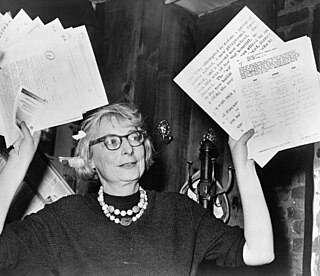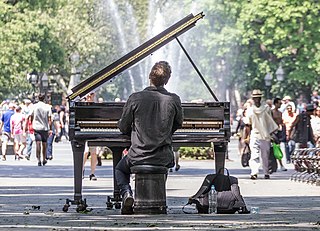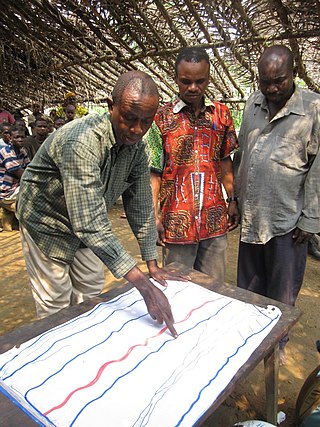Related Research Articles
Regional science is a field of the social sciences concerned with analytical approaches to problems that are specifically urban, rural, or regional. Topics in regional science include, but are not limited to location theory or spatial economics, location modeling, transportation, migration analysis, land use and urban development, interindustry analysis, environmental and ecological analysis, resource management, urban and regional policy analysis, geographical information systems, and spatial data analysis. In the broadest sense, any social science analysis that has a spatial dimension is embraced by regional scientists.

Jane Jacobs was an American-Canadian journalist, author, theorist, and activist who influenced urban studies, sociology, and economics. Her book The Death and Life of Great American Cities (1961) argued that "urban renewal" and "slum clearance" did not respect the needs of city-dwellers.

Landscape architecture is the design of outdoor areas, landmarks, and structures to achieve environmental, social-behavioural, or aesthetic outcomes. It involves the systematic design and general engineering of various structures for construction and human use, investigation of existing social, ecological, and soil conditions and processes in the landscape, and the design of other interventions that will produce desired outcomes.
This is a list of lists of people by occupation. Each is linked to a list of notable people within that profession.

The American Planning Association (APA) is a professional organization representing the field of urban planning in the United States. APA was formed in 1978, when two separate professional planning organizations, the American Institute of Planners and the American Society of Planning Officials, were merged into a single organization. The American Institute of Certified Planners is now the organization's professional branch.

Constantinos A. Doxiadis, often cited as C. A. Doxiadis, was a Greek architect and urban planner. During the 1960s, he was the lead architect and planner of Islamabad, which was to serve as the new capital city of Pakistan. He was later known as the father of ekistics, which concerns the multi-aspect science of human settlements.

Giancarlo De Carlo (1919−2005) was an Italian architect and anarchist. He was a member of the Congrès Internationaux d'Architecture Moderne (CIAM) and became closely linked to Urbino as its town planner and creator of its master plan. Throughout his architecture career he advocated for the consideration of human, physical, cultural, and historical forces in design.

Ecumenopolis is the hypothetical concept of a planetwide city.

Léon Krier CVO is a Luxembourgish architect, architectural theorist, and urban planner, a prominent critic of modernist architecture and advocate of New Classical architecture and New Urbanism. Krier combines an international architecture and planning practice with writing and teaching. He is well known for his master plan for Poundbury, in Dorset, England. He is the younger brother of architect Rob Krier.
Landscape planning is a branch of landscape architecture. According to Erv Zube (1931–2002) landscape planning is defined as an activity concerned with developing landscaping amongst competing land uses while protecting natural processes and significant cultural and natural resources. Park systems and greenways of the type designed by Frederick Law Olmsted are key examples of landscape planning. Landscape designers tend to work for clients who wish to commission construction work. Landscape planners analyze broad issues as well as project characteristics which constrain design projects.
The MacArthur Fellows Program, also known as the MacArthur Fellowship and colloquially called the "Genius Grant", is a prize awarded annually by the John D. and Catherine T. MacArthur Foundation to typically between 20 and 30 individuals working in any field who have shown "extraordinary originality and dedication in their creative pursuits and a marked capacity for self-direction" and are citizens or residents of the United States.
H. Peter Oberlander, was a Canadian architect and Canada's first professor of Urban and Regional Planning.

Placemaking is a multi-faceted approach to the planning, design and management of public spaces. Placemaking capitalizes on a local community's assets, inspiration, and potential, with the intention of creating public spaces that improve urban vitality and promote people's health, happiness, and well-being. It is political due to the nature of place identity. Placemaking is both a process and a philosophy that makes use of urban design principles. It can be either official and government led, or community driven grassroots tactical urbanism, such as extending sidewalks with chalk, paint, and planters, or open streets events such as Bogotá, Colombia's Ciclovía. Good placemaking makes use of underutilized space to enhance the urban experience at the pedestrian scale to build habits of locals.

Christopher Charles Benninger is an Indian architect and urban planner. Born in the US, he permanently migrated to India in 1971. Benninger contributed to the field of critical regionalism and sustainable planning in India.

Participatory planning is an urban planning paradigm that emphasizes involving the entire community in the community planning process. Participatory planning emerged in response to the centralized and rationalistic approaches that defined early urban planning work.

Erica Mann was an architect and town planner who lived and worked in Kenya for almost all her adult life, after fleeing her home in Romania during the Second World War. She made a significant contribution to the 1948 master plan for Nairobi and also took a leading role in planning Mombasa and other parts of Kenya. She became interested in development projects seeking to improve living standards and was director of the "Women in Kibwezi" project, which was recognised at the United Nations Habitat II conference in 1996. The "Woman in Kibwezi" project was but one of several NGOs she headed across Kenya, many of them engaged in fostering women's cooperatives. In 2003 she was honoured with the title of Architect Laureate for Kenya.
Richard Louis Meier was a US regional planner, systems theorist, scientist, urban scholar, and futurist, as well as a Professor in the College of Environmental Design at the University of California at Berkeley. He was an early thinker on sustainability in planning, and recognized as a leading figure in city planning and development. He is not related to the New York-based architect Richard Meier, whom he was often confused with.

The Urban Design Forum is a not-for-profit New York organization devoted to urban design. It seeks to amplify the influence and understanding of urban design's role in creating dynamic, cooperative, competitive, and sustainable cities. The organization was formed from the merger of the Institute for Urban Design and the Forum for Urban Design in March 2014.
Unified settlement planning (USP) is the component of regional planning where a unified approach is applied for a region's overall development. The USP approach is most often associated with urban planning practices in India.
Mary Jaqueline Tyrwhitt was a British town planner, journalist, editor and educator. She was at the centre of the transnational network of theoreticians and practitioners who shaped the post-war Modern Movement in decentralized community design, residential architecture and social reform. She contributed in developing methods for the application of the ideas of Patrick Geddes, as well as publicizing them. Even Tyrwhitt had never met Geddes, she was able to extract from his many writings key ideas and concepts to disseminate among her colleagues and injected Geddesian thinking into conferences, discussions, curricula, publications, and policy documents.
References
- Wendy Hui Kyong Chun and Thomas Keenan, ed., New media, old media: a history and theory reader, p. 394, ISBN 0-415-94224-1
- Wigley, Mark, 2001, Network Fever, in Grey Room (MIT Press Journal), 4, pp. 82–122.